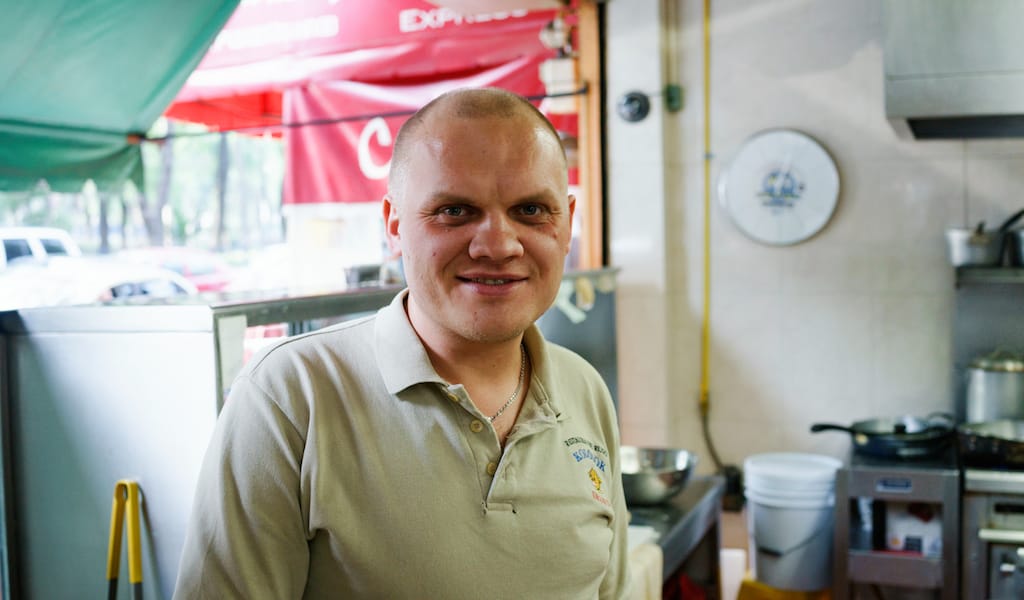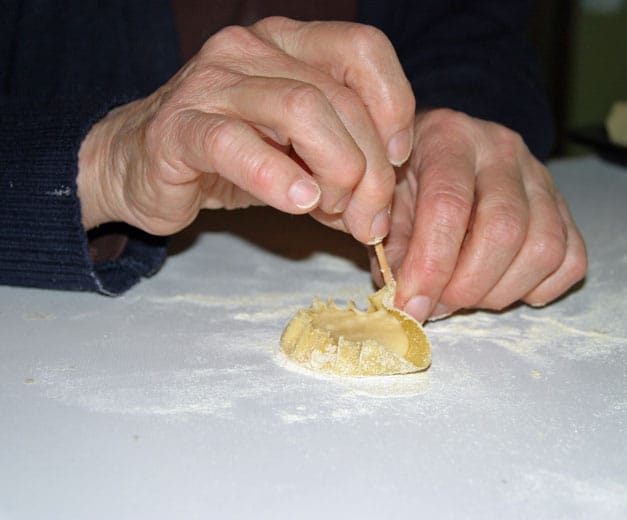Watching old Greek movies from the 1950s, ’60s and ’70s has been a rite of passage for every single generation raised in Greece from the ’80s onwards. When we were young, these movies played endlessly on TV, getting us acquainted with the Greece our parents grew up in. There were a number of things that both puzzled and delighted us – chief among them, the patisserie-as-meeting-place. The heroine, wearing a pillbox hat over expertly coiffed hair, would meet her girlfriends or potential love interest in grand-looking pastry shops, where she would be served by waiters in uniforms and eat a pasta, an individual portion of dessert: soft sponge cake with almond and cream or chocolate fillings.
The onscreen Athens centered on Patissia and Kypseli, neighborhoods which had already fallen from grace by the late ’80s, as their residents slowly abandoned them for the suburbs. Most films have a close-up of Patission Avenue, which connected Omonia Square to those neighborhoods. The street, whose official name is actually 28is Oktovriou, is home to some of Athens’ most important landmarks, including the National Archeological Museum and the Νational Technical University, and has undergone some dramatic changes in the past years. It is now a bit run-down, with a number of empty shops and buildings.
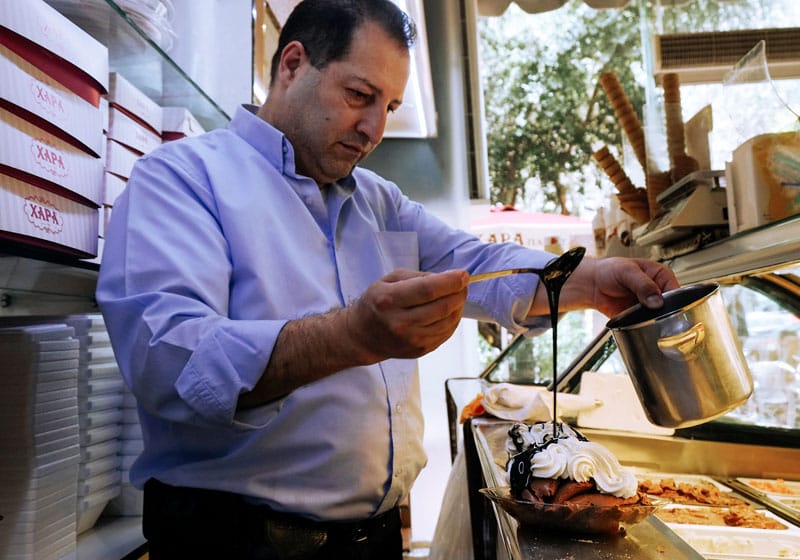
Xara (pronounced “Chara”) sits near the end of the avenue by the Ano Patissia suburban railway station. The shop opened in 1969, right when the golden era of the patisserie-as meeting-place concept was coming to an end.
And yet, despite the fact that Athenians have long since abandoned patisseries as meeting points, Xara has remained a popular spot. The original owner, Xara, came from Istanbul and apparently carried the recipe for ekmek and kaymak in her shoe. Her family still owns the place. It looks like it’s stuck firmly in the ’80s, with its sepia glass walls, old-fashioned logo and an enormous brown catalog listing desserts such as Rocky, Coucou’s Nest, Maracaibo ice cream (milk chocolate with dark cherries) and Pasha ice cream (baklava ice cream with kaymak). The desserts often come in elaborate presentations. An ice cream we ordered came inside a glass with a base of floating penguins and was topped with an Italian flag! The shop started out offering “Istanbul-style” desserts but made its name selling two things: ekmek topped with kaymak ice cream, and a wonderful ice cream concoction called Chicago.
Ekmek varies widely depending on whether you are in Greece or Turkey. Xara’s ekmek is closer to the Turkish version, in which the bottom is essentially a bread pudding drenched in syrup and then topped with kaymak, a luscious clotted cream made from buffalo’s milk. In Greece the base is usually made with kataifi, the finely shredded phyllo widely used in desserts around the Middle East, and topped with whipped cream and pistachios or almonds. Xara offers six versions of ekmek, including the güzel ekmek (bread pudding base, buffalo clotted cream) and an ekmek with vanilla ice cream.
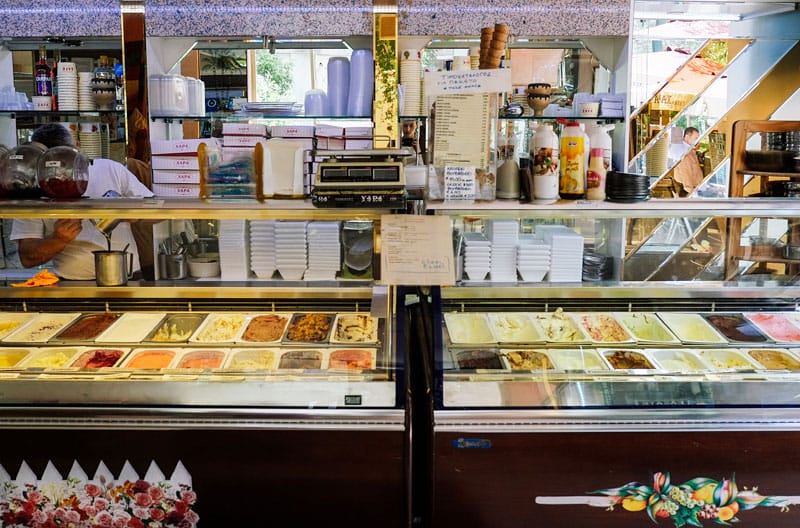
For the most popular version, the ekmek topped with kaimaki (the Greek name for kaymak) ice cream, Xara specifies on its menu that it uses ice cream made from buffalo milk. (Bear in mind that this is not always the case, as kaimaki ice cream in Greece is usually similar to Turkish dondurma in that it’s made with heavy cream, milk and sugar, as well as mastic and sahlep, a powder made from the root of wild orchids.) The base is almost chewy with sweet syrup and is complemented perfectly by the rich, slippery ice cream. It’s a masterpiece. And at €7.50, it’s also a pricey dessert by Athenian standards.
The Chicago is a nostalgic classic loved by children, combining chocolate ice cream with whipped cream, chocolate sauce and chopped almonds on top. It’s a chocoholic’s dream – and is even better when the ice cream begins to melt and pools into the chocolate sauce.
Although much of the Athens in those old movies has long disappeared, Xara has survived, doing what it has always done. So grab your pillbox hat – we’ll see you there.
 January 23, 2019 Kolobok
January 23, 2019 Kolobok
Located in the picturesque neighborhood of Santa Maria la Ribera, Kolobok – the little […] Posted in Mexico City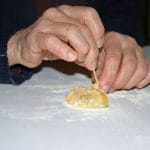 April 10, 2015 Melitinia
April 10, 2015 Melitinia
The Holy Week in Greece is full of scents and flavors. Ovens work overtime baking […] Posted in Athens January 20, 2021 Tizne Tacomotora
January 20, 2021 Tizne Tacomotora
With its neo-industrial decor, Tizne looks like a lot of new Mexico City restaurants and […] Posted in Mexico City
Published on July 30, 2014
Related stories
January 23, 2019
Mexico CityLocated in the picturesque neighborhood of Santa Maria la Ribera, Kolobok – the little Russian restaurant that could – bustles in the Mexico City dusk one recent Sunday afternoon. Patrons cluster around the warm light of the to-go window, shouting out empanada orders over the sound of a band playing nearby in the neighborhood’s Plaza…
April 10, 2015
AthensThe Holy Week in Greece is full of scents and flavors. Ovens work overtime baking brioches (tsourekia), Easter biscuits and melitinia, diminutive sweets that originate from Santorini. Traditionally, melitinia are made by women and girls on Holy Tuesday to be eaten on the evening of the Resurrection and the coming days of Easter (Orthodox Easter…
January 20, 2021
Mexico CityWith its neo-industrial decor, Tizne looks like a lot of new Mexico City restaurants and shops riding the “rough hewn” interiors wave. Metal chairs, uncovered cement walls and digital art work give the place the feeling of a warehouse or underground club, albeit one that happens to have amazing tacos. Tizne’s full name, Tizne Tacomotora…













































